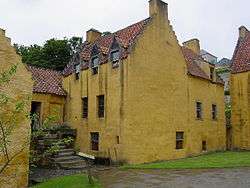George Bruce of Carnock

Sir George Bruce of Carnock (c. 1550 – 1625) was a Scottish merchant and engineer. He was born in Carnock, near Dunfermline.
Coal mining
Bruce was an innovator in coal mining techniques, introducing undersea mining into the Upper Hirst seam with use of new drainage technology.[1] These innovations attracted much interest, including a visit from King James VI in 1617. Sir George Bruce invited him to visit one of his mines which tunnelled down beneath the sea bed. James ventured into the tunnel which went far out into the Firth of Forth and found himself at a shaft point where the coal was loaded onto the ships. Alarmed to find himself surrounded by water at the top of the shaft, James accused Sir George of an attempt on his life and declared that the whole affair was an act of treason. It was only when George Bruce pointed out the rowing boat and explained that one could either use that or return by the tunnel from whence they came that James relaxed again - and took the option of the boat journey.[2]
Culross Palace
Between 1597 and 1611,[2] Bruce built a mansion house in Culross, using materials from his foreign trading. This building has subsequently become known as Culross Palace. He lavishly decorated the palace and the stunning painted ceilings, ornate features and panelling can still be seen. Culross Palace is now under the care of the National Trust for Scotland and has been restored to its 17th-century splendour.[3] The palace building, which had faded to a white wash has been restored to its original yellow-orange exterior. The courtyard path and the garden have also been remodelled, with the garden now full of vegetables, herbs and plants, growing as they would have done in the 17th century.[4]
Death
Bruce died on 6 May 1625 and was buried in Culross Abbey.
Legacy
In 2015 he was inducted into the Scottish Engineering Hall of Fame.[5]
References
- ↑ "Papers on Mining in Scotland, 18th and 19th centuries". Archives Hub. Retrieved 17 October 2008.
- 1 2 "Culross". BBC. Retrieved 17 October 2008., Robert Chambers, Domestic Annals of Scotland, vol. i, (1858), 481, citing Forsyth's Beauties of Scotland
- ↑ "Property Details for Culross". National Trust for Scotland. Retrieved 17 October 2008.
- ↑ "Listed Building Report". Historic Scotland. 12 January 1972. Retrieved 17 October 2008.
- ↑ http://engineeringhalloffame.org/ accessed 4 October 2015